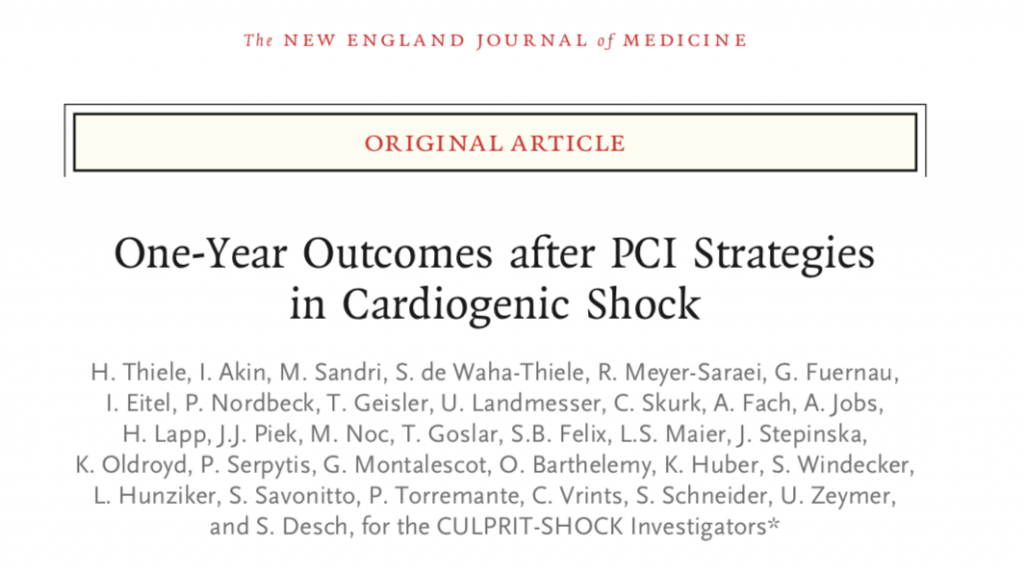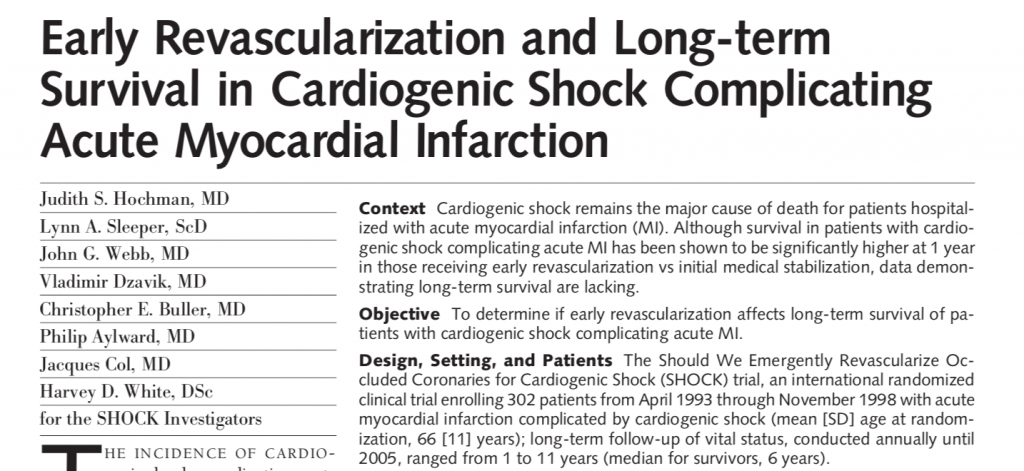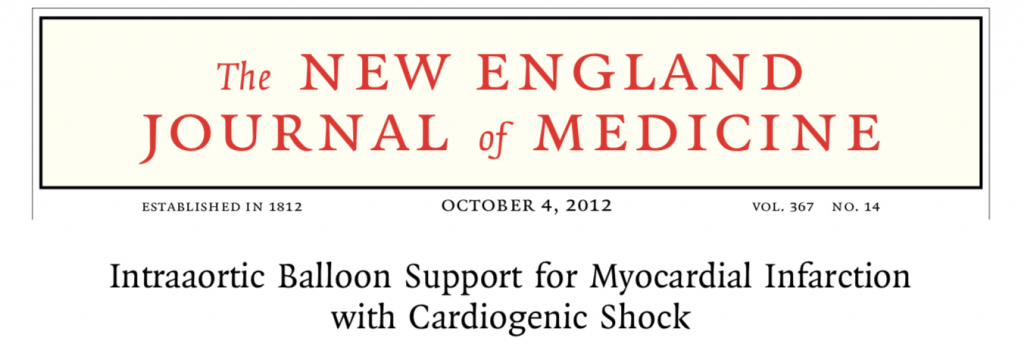There was really nothing to do with a patient with acute myocardial infarction in my times as a junior doctor in Delhi. We did not even know that aspirin by itself if given on time lowered deaths by 25%. I worked in one of there largest teaching hospitals in town. Thrombolytic therapy was to come almost half a decade later. I in fact was the first doctor to administer intravenous streptokinase in a woman admitted for acute inferior myocardial infarction in 1983; I was by now a resident at G B pant Hospital, Delhi. The dose given was homeopathic by todays standards, only 500,000 units of streptokinase, but the drug seemed to work because there was substantial resolution of the ST segments. An angiogram done some days later demonstrated a patent right coronary artery. In those days the only hospital doing coronary angiograms apart from AIIMS was G B Pant Hospital. But there was still no treatment for cariogenic shock (CS) complicating acute myocardial infarction (AMI). In the late eighties I realised in a randomised study that intravenous streptokinase opened just about 25% of the culprit arteries while intracoronary streptokinase could recanalise more than two third culprit vessels in patients with AMI.
The SHOCK investigators presented data on the role of revascularisation in patients with AMI accompanied with shock for the first time in 1999 (N Engl J Med 1999; 341: 625-34). The researchers reminded the cardiological community that the incidence of shock ranged from 7% to 10% of all AMI patients. Also that cardiogenic shock carried the dreaded mortality figures of 60 to 80%. There seemed to be no effective treatment for AMI accompanied by CS till the SHOCK data got published. No significant difference in morality was seen at 30 days between patients treated with revasularisation and those treated medically ( 47% and 56% ; p=0.11) .But by 6 months the researchers found a significant absolute 13% reduction with revasularisation compared to medical treatment ( 50% vs. 63%; p= 0.027). It should be clarified that the majority of patients underwent balloon angioplasty alone with a third getting coronary stents. About one third patients with extensive coronary disease underwent coronary bypass graft surgery. The authors strongly recommended urgent revascularisation in patients of AMI complicated with CS.
The SHOCK investigators came up with another randomised trial in 2006 (JAMA 2006; 295: 2511-15) that reported almost two thirds of patients who survived from cariogenic shock by early revasularization were alive at 6 years. The authors reiterated that patients of AMI with CS must be managed by early revascularization. Six year survival rates for hospital survivors were 62% versus 44% for the early revascularization and initial medical stabilisation groups. A strategy off early revascularization resulted in a 13% absolute and 67% relative reduction in mortality at 6 years. The SHOCK trial had randomised 302 patients of AMI with CS. The survival benefit was seen upto 11 years. It must be noted that the SHOCK investigators did not report significant difference in survival by early revascularization; the mortality benefit accrued in later years.
The current European Society of Cardiology meeting has witnessed the latest data on treatment of AMI complicated by shock. It is now clear that the best chance for survival in a patient of AMI with cariogenic shock is early revsacularizatiuon. But the jury is still out whether to treat the culprit artery alone during the index procedure or treat all stenosed vessels in patients with shock. Investigators of the CULPRIT-SHOCK trial report that mortality is significantly less at 30 days when culprit vessel alone is treated with percutaneous coronary intervention (PCI) as compared with tackling multiple coronary stenoses. The composite endpoint of death and severe renal failure occurred in 46% of patients in the culprit only PCI group and in 55% in the multiverse PCI group (p=0.01). The CULPRIT- SHOCK trial randomised 706 AMI patients with shock ( N Engl J Med 2018, 25 th August).
However by 1 year there was no significant difference in deaths in the 2 groups. At 1 year death had occurred in 50% of culprit only PCI and in 57% in the multiverse PCI group. Repeat revasularization occurred more frequently in the culprit only PCI patients. How does one explain the results. The authors themselves point out that mortality is seen most in the first 30 days after AMI complicated with shock. This can range from 35% to 60%. Death rates thereafter range from 7% to 12% approximately for the next 11 months. Rates of re-hospitalisation were less in the multiverse PCI group because of probable greater improvement in left ventricle function. But short term risks are more with multiverse PCI; the reasons being longer procedural duration, greater employment of contrast that can compromise left ventricle function. The CULPRIT-SHOCK investigators however did not report on left ventricle function change assessed by 2 D echocardiography. Basal left ventricle ejection fraction was around 33%. The early survival benefit of culprit only PCI in AMI and CS was sustained at 1 year.
The role of an intra aortic balloon pump in the treatment of cariogenic shock was not found to be helpful in randomised trials although intuitively thought to be beneficial. More than 95% patients in the SHOCK trial had a balloon pump inserted, but the SHOCK-IABP investigators concluded that in patients undergoing early revascularization for myocardial infarction complicated with cariogenic shock, a balloon pump did not reduce 12 month all cause mortality ( Lancet 2013; 382: 1638- 45)). About 50% of patients had died in both groups ( with and without an IABP), there were no significant differences reinfarctiron, recurrent revascularization or stroke. The authors had explained there results by the fact that death in cariogenic shock is due to 3 factors. The first is hemodynamic deterioration, the second reason is multi organ dysfunction and the third systemic inflammation. In SHOCK IABP there was no difference in blood pressure or heart rate by a balloon pump, there was no change in multi-organ dysfunction, and nor were there any benefit seen with CRP to lactate levels. The balloon pump despite reducing after load and augmenting diastolic flow does not significantly increase cardiac output in shock patients. But still almost 30% of patients in the CULPRIT-SHOCK trial had mechanical circulatory support ( IABP or Impella ventricular assist device), and as many as 80% had some form of mechanical ventilation.
What then are the take home messages ? Available evidence strongly suggest that patients with AMI complicated with cariogenic shock deserve early revasularization. The majority of such patients should undergo PCI at the earliest. There is no mortality advantage of inserting an intra aortic ballon pump as an adjunct to PCI. In the event of multi vessel disease it would be prudent to tackle the culprit artery during the index procedure. A strategy of culprit vessel only PCI in AMI and shock is the best approach as per the latest evidence. Mortality in cardiogenic shock is as high as 50% at one year in spite of all contemporary methods.
Cardigenic shock is defined as systolic blood pressure less than 90 mm Hg for 30 minutes, need of catecholamine support to maintain bold pressure above 90 m Hg, signs of pulmonary congestion and at least one sign of organ dysfunction ( cold clammy skin, altered mental status, urine output less than 30 ml per hour, artery lactate more than 2 mmol/L).



